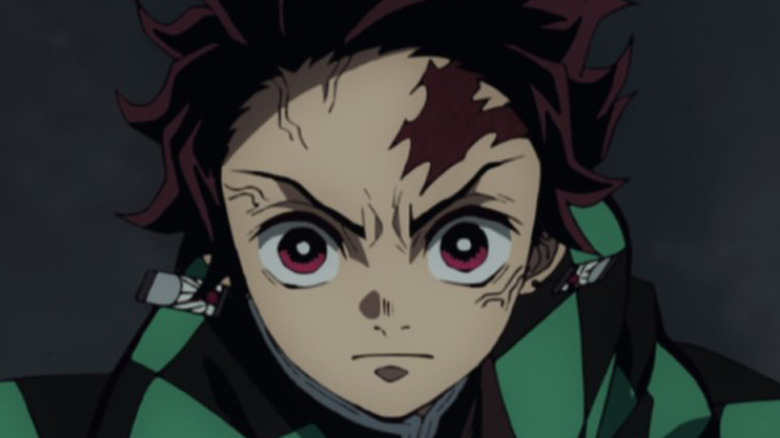The Full Japanese Title Of Demon Slayer Means More Than You Think
Hit anime "Demon Slayer" has loomed large in the zeitgeist, both abroad in Japan and domestically in America. The movie, whose full title is "Demon Slayer: Kimetsu no Yaiba: The Movie: Mugen Train," quickly made a name for itself by earning 10 billion yen faster than any movie in Japanese cinema history, breaking a record previously held by another animated film, "Spirited Away." It soon went on to become the most financially successful film in Japanese history (via Hollywood Reporter). "Mugen Train" is unique for an anime movie based on a popular series in that it's a direct sequel to the 26-episode first season of "Demon Slayer," rather than a spin-off like the standalone "My Hero Academia: Two Heroes" released in 2018.
In the U.S., "Mugen Train" not only led in box office earnings during the week of its release, but earned the most money during its opening weekend of any non-English language film ever released stateside. Likely contributing to the film's success, is the fact that enjoyment of the film is largely predicated on watching the 26 episodes of "Demon Slayer" that precede it. For existing fans of "Demon Slayer," then, "Mugen Train" is required viewing. By that same token, those first hearing of "Demon Slayer" due to the meteoric success of the "Mugen Train" film have some homework to finish before they can properly enjoy the biggest film in Japanese history.
Seasoned American "Demon Slayer" fans, however, may not realize the true depth of meaning in its original Japanese title.
The ancient blade killed demons in the past
In English, "Demon Slayer" is titled "Demon Slayer: Kimetsu no Yaiba" in full. In Japan, however, the series is simply titled "Kimetsu no Yaiba." Furthermore, "Demon Slayer" is a loose translation of "Kimetsu no Yaiba," meaning that its extended English title is technically redundant. That said, unpacking the meaning of "Kimetsu no Yaiba" reveals considerably more nuance than the mere concept of killing demons.
In Japanese, "Kimetsu no Yaiba" is written 鬼滅の刃. The first two characters, 鬼滅, are not an existing word when combined with one another, making it a creation of series author Koyoharu Gotoge. The former character, 鬼, pronounced "ki," means demon (via Jisho) and is typically pronounced "oni" in isolation. "Oni" is specifically a type of Japanese demon, rather than a Western, Christian demon. The latter, 滅 or "metsu," means "destroy." That said, according to a post on the Hiro8 Japanese Culture Blog by a native Japanese speaker, 滅 (typically part of a verb like 滅する, or "messuru") is archaic in modern Japanese. Thus, 鬼滅 not only communicates the idea of eradicating demons, but of doing so in the past, like, for example, in the series' Taisho period-inspired setting.
The next character, の or "no," is simply a phonetic hiragana character that serves to grammatically connect the nouns before and after it. Finally, also according to the Hiro8 Japanese Culture Blog, 刃, pronounced "yaiba," refers specifically to the blade portion of a sword. "Yaiba," too, is an outdated pronunciation.
"Kimetsu no Yaiba," then, suggests a blade that eradicates demons. The use of archaic Japanese likens the title to a term that may have been previously used in Japanese history, rather than today, imbuing this hypothetical demon-slaying blade with some historical context.

